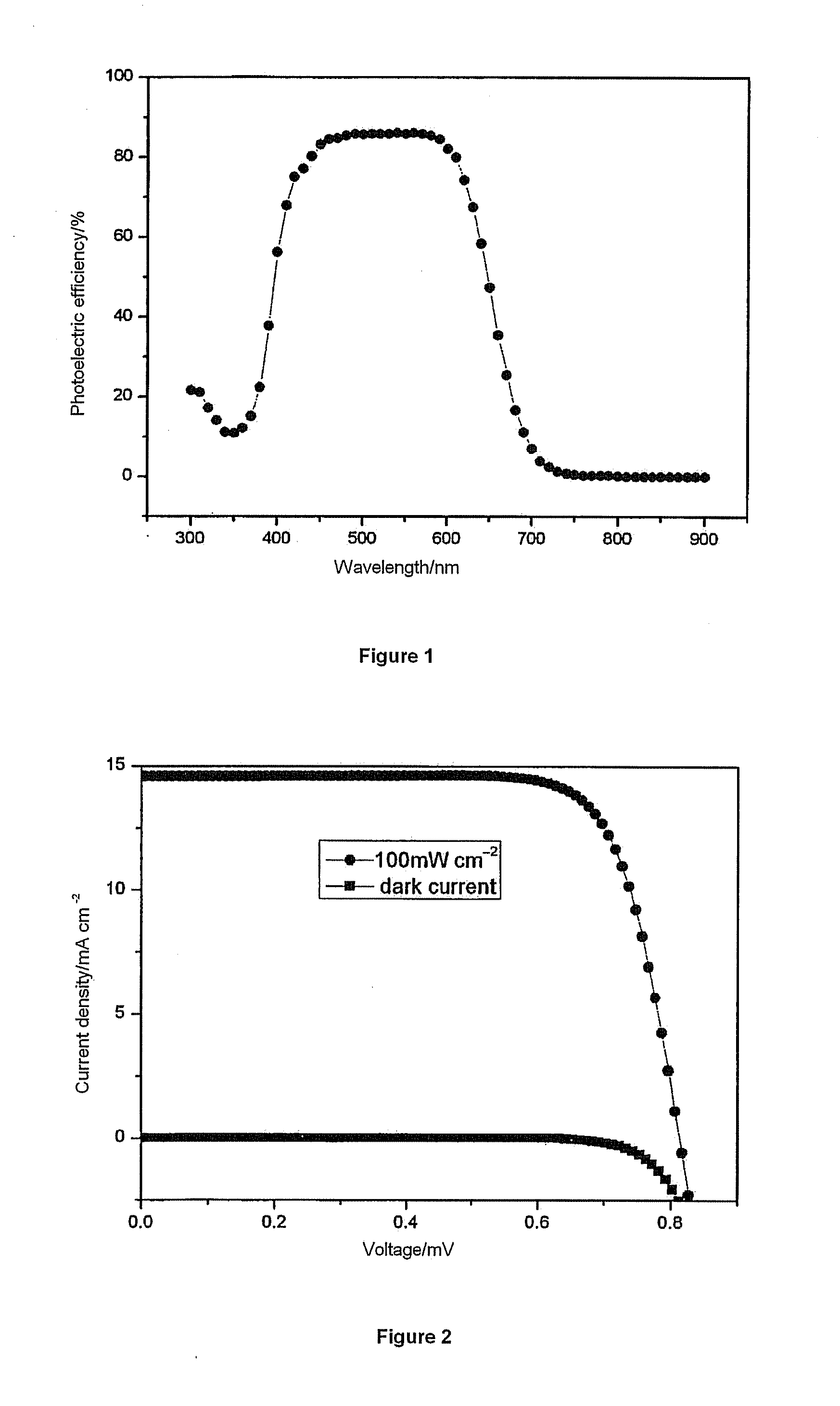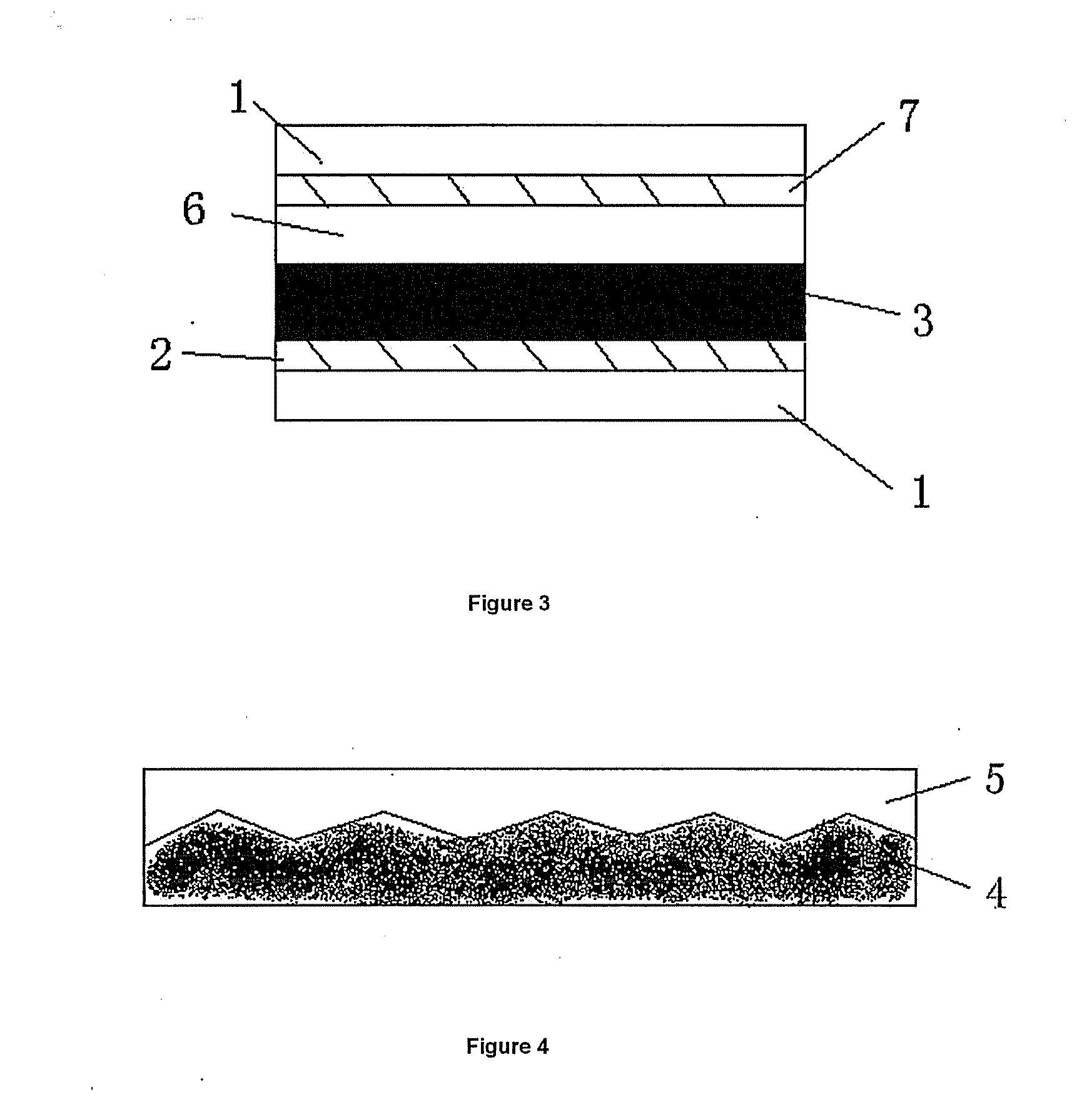Organic dyes and preparation method thereof and dye-sensitized solar cells
a technology of organic dyes and solar cells, which is applied in the field of organic dyes and a preparation method thereof, can solve the problems of high production cost, limited practical application of dyes containing noble metals, and high cost of raw materials in silicon solar cells, and achieves low cost for starting materials, simple synthesis process, and easy purification
- Summary
- Abstract
- Description
- Claims
- Application Information
AI Technical Summary
Benefits of technology
Problems solved by technology
Method used
Image
Examples
example 1
Preparation of Organic Dye I
[0035]The synthesis route is as follows:
[0036]Synthesis of Intermediate 2:
[0037]In a reactor, 1.35 g compound 1 and 0.80 ml N,N-dimethylformamide were dissolved in 10 ml 1,2-dichloroethane. The reaction system was protected under Ar, and cooled to 0° C. 0.42 ml phosphorus oxychloride was added, and the reaction was performed at 0° C. for 4 hours. Then, 20 ml saturated sodium acetate aqueous solution was added, followed by stirring for 2 hours. Dichloromethane was used for extraction, and the organic phase was dried with anhydrous sodium sulfate. After removing solvent, the resultant was subject to column chromatography using dichloromethane / petroleum ether as the eluent to give intermediate 2 with a yield of 87%.
[0038]Synthesis of Intermediate 3:
[0039]In a reactor, 0.6 g intermediate 2 was dissolved in 45 ml tetrahydrofuran followed by being cooled to −78° C., and 0.31 g N-bromo-succinimide was added. The temperature was slowly raised to room temperature ...
example 2
Preparation of Organic Dye II
[0049]The synthesis route is as follows:
[0050]Synthesis of Intermediate 8:
[0051]In a reactor, 1.87 g compound 7 and 0.96 ml N,N-dimethylformamide were dissolved in 100 ml 1,2-dichloroethane. The reaction system was protected under Ar, and cooled to 0° C. 0.96 ml phosphorus oxychloride was added, and the reaction was performed at 0° C. for 2 hours, and then at 40° C. for 4 hours. Then, 50 ml saturated sodium acetate aqueous solution was added, followed by stirring for 2 hour. Dichloromethane was used for extraction, and the organic phase was dried with anhydrous sodium sulfate. After removing solvent, the resultant was subjected to column chromatography using ethyl acetate / petroleum ether as the eluent to give intermediate 8 with a yield of 91%.
[0052]Synthesis of Intermediate 9:
[0053]In a reactor, 0.7 g intermediate 8 was dissolved in 45 ml tetrahydrofuran followed by being cooled to −78° C., and 0.52 g N-bromo-succinimide was added. The temperature was s...
example 3
Preparation of Organic Dye III
[0060]The synthesis route is as follows:
[0061]Synthesis of Intermediate 12:
[0062]In a reactor, 1 g compound 11 was dissolved in 84 ml tetrahydrofuran followed by being cooled to −78° C. The reaction system requires oxygen-free and water-free. 2.23 ml n-butyl lithium was added dropwisely, and the reaction was performed at −78° C. for 3 hours. 1.04 ml tributyl tin chloride was added dropwisely, and the reaction was performed at −78° C. for 3 hours and then at room temperature for 16 hours. 10 ml water was added to quench the reaction, and tetrahydrofuran was removed under reduced pressure. The aqueous phase was extracted with ethyl acetate, and the organic phase was dried with anhydrous sodium sulfate. After removing the solvent, intermediate 12 was obtained with a yield of 98%.
[0063]Synthesis of Intermediate 14:
[0064]In a reactor, 0.895 g intermediate 12, 1.34 g compound 13, and 0.1 g bis(triphenylphosphine)dichloropalladium were dissolved in 20 ml N,N-d...
PUM
 Login to View More
Login to View More Abstract
Description
Claims
Application Information
 Login to View More
Login to View More - R&D
- Intellectual Property
- Life Sciences
- Materials
- Tech Scout
- Unparalleled Data Quality
- Higher Quality Content
- 60% Fewer Hallucinations
Browse by: Latest US Patents, China's latest patents, Technical Efficacy Thesaurus, Application Domain, Technology Topic, Popular Technical Reports.
© 2025 PatSnap. All rights reserved.Legal|Privacy policy|Modern Slavery Act Transparency Statement|Sitemap|About US| Contact US: help@patsnap.com



